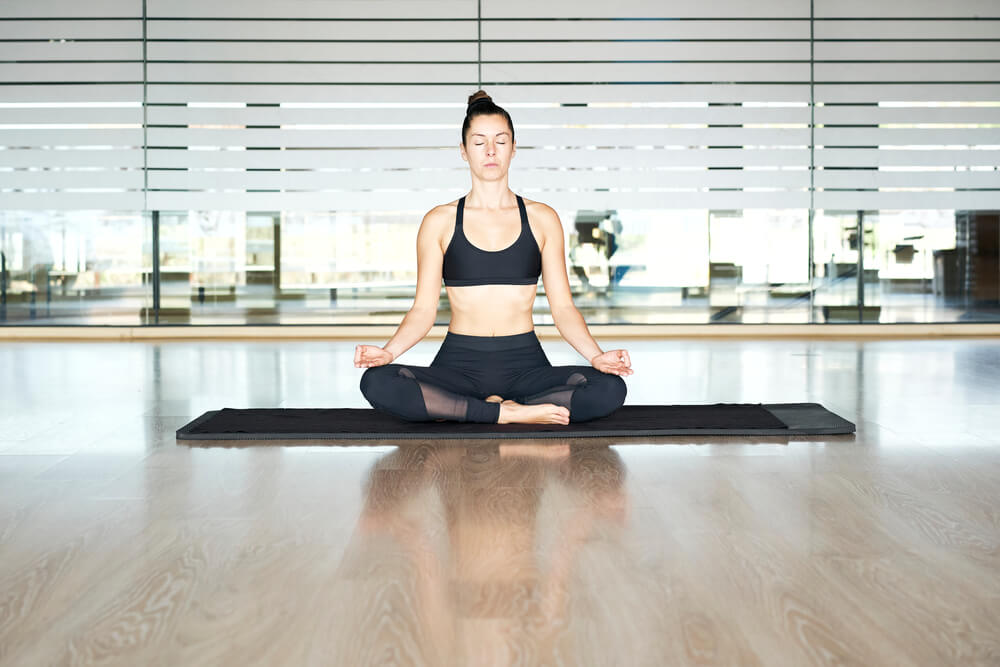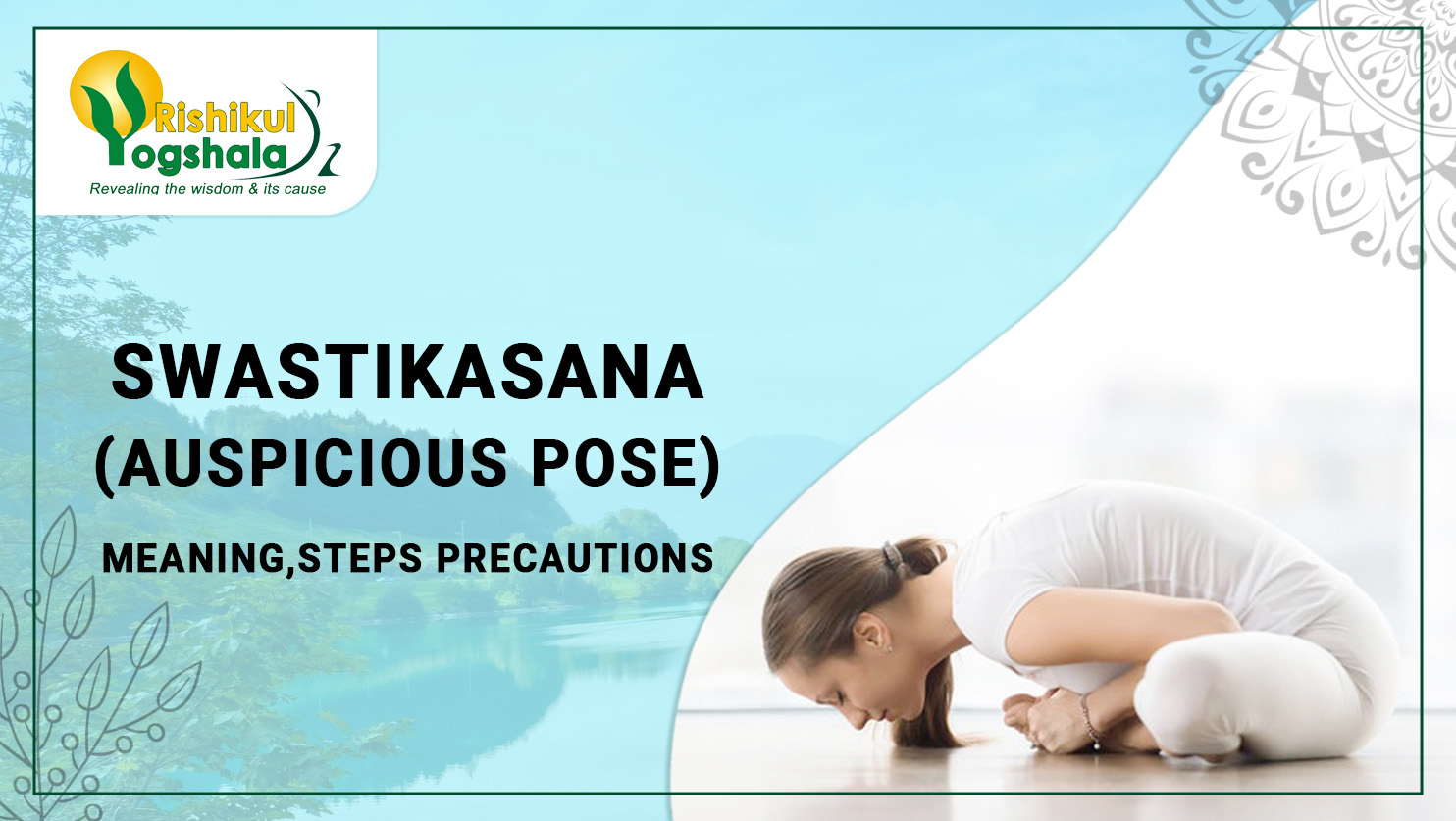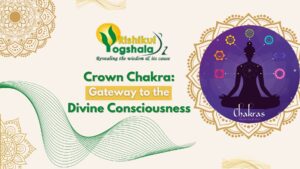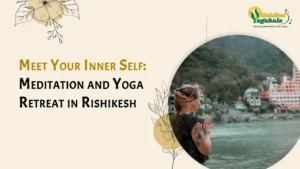In the yoga world, every posture has its reasons- some that date back centuries due to tradition, symbolism, mental, physical & spiritual balance. Out of them, one such yoga pose that bestows the practitioner with a blessing/swastik is the Swastikasana. Swastikasana – स्वस्तिकासन Definition – Derived from the Sanskrit word ‘Swastika’, which means auspicious, Swastikasana symbolises a combination of stability, equanimity and transcendence. Learn about Swastikasana’s meaning, steps, and precautions on this blog post to deepen your practice.
Understanding Swastikasana
Swastikasana is a seated yoga posture that helps you feel grounded and at inner peace. In many religious traditions, it carries a sacred meaning, representing prosperity, good fortune, and a peaceful environment. ‘Swastika’ is derived from the Sanskrit word ‘Swasti’, which means auspicious or good fortune.
The body in this posture forms a stable and well-balanced outline of the Swastika, a symbol which in Hinduism, Buddhism, and Jainism is considered very sacred. Swastika Swastika symbolizes the eternal cycle of birth, preservation, and death, cosmic order, and divine blessings.

Steps to Practice Swastikasana
- Find a Quiet Space: Begin by selecting a quiet and serene environment for your practice. Ensure that the space is free from distractions to facilitate a deeper connection with your inner self.
- Sit Comfortably: Sit on the floor with your legs stretched out in front of you.
- Cross the Legs: Bend your right knee and place the sole of your right foot against the inner thigh of your left leg. Ensure that your right heel is nestled close to your groin.
- Cross the Left Leg: Now, bend your left knee and place the sole of your left foot against the inner thigh of your right leg. Your left heel should rest comfortably against your groin, mirroring the position of the right foot.
- Align the Knees: Make sure that both knees are touching the ground, forming a stable foundation for the pose.
- Straighten the Spine: Lengthen your spine upward, keeping it erect yet relaxed. Contract the muscles in your core to support your back.
- Place Hands on Knees: Rest your hands gently on your knees with palms facing downward. Alternatively, you can adopt Chin Mudra by touching the tip of your index finger to the tip of your thumb with the remaining fingers extended.
- Relax and Breathe: Close your eyes softly and focus on your breath. Inhale deeply through your nose, expand your abdomen, and exhale slowly, releasing any tension or stress.
- Maintain the Pose: Hold the Swastikasana for a few breaths or as long as comfortable, allowing your body to relax and surrender into the posture.

Precautions and Modifications
While Swastikasana is generally safe for most individuals, it’s essential to practice it mindfully and with awareness of your body’s limitations. Let’s talk about several modifications and safety precautions to consider:
- Knee Sensitivity: If you have knee injuries or discomfort, you can place a cushion or folded blanket beneath your knees for added support and cushioning.
- Hip Flexibility: Individuals with tight hips may find it challenging to cross their legs in Swastikasana comfortably. In such cases, you can modify the pose by sitting on a folded blanket or bolster to elevate the hips and reduce strain on the knees and hips.
- Back Support: If you experience discomfort in your lower back, you can place a bolster or cushion behind your lower back for added support and alignment.
- Breathing: Focus on maintaining smooth and steady breaths throughout the practice. Throughout the pose, try not to strain or hold your breath.
- Gradual Progression: If you’re new to Swastikasana or have limited flexibility, practice gradually and listen to your body’s feedback. Over time, you can work towards achieving a deeper and more comfortable seated position.
- Consultation: If you have any underlying medical conditions or concerns, consult with a qualified yoga instructor or healthcare professional before practising Swastikasana.

Benefits of Swastikasana (Auspicious Pose)
Let’s explore some of the profound advantages of incorporating Swastikasana into your yoga routine:
1. Enhances Concentration and Focus: Swastikasana encourages mindfulness and concentration by fostering a serene and meditative state of mind. The balanced alignment of the body promotes mental clarity and sharpens focus, making it an ideal posture for meditation and introspection.
2. Improves Posture and Spinal Health: Sitting in Swastikasana helps align the spine, elongating the vertebral column and promoting good posture. By strengthening the muscles of the back and abdomen, this pose alleviates tension and discomfort, reducing the risk of spinal misalignment and related issues.
3. Stimulates Digestion and Metabolism: The gentle compression applied to the abdomen in Swastikasana massages the digestive organs, promoting healthy digestion and optimal functioning of the gastrointestinal system. This can help alleviate digestive issues such as indigestion, bloating, and constipation while also stimulating metabolism.
4. Calms the Mind and Relieves Stress: Swastikasana induces a sense of tranquillity and inner peace, calming the fluctuations of the mind and reducing stress and anxiety. By practising deep breathing and mindful relaxation in this pose, you can release tension stored in the body and cultivate a state of profound relaxation.
5. Increases Flexibility and Joint Mobility: Regular practice of Swastikasana enhances flexibility in the hips, knees, and ankles, improving overall joint mobility and range of motion. As the hip flexors and groin muscles stretch and release, stiffness and tightness are alleviated, promoting greater ease of movement.
Also Read: Ashtanga Namaskara (Eight-Limbed Salutation)
6. Balances Energy Flow (Prana): Swastikasana facilitates the balanced flow of prana (life force energy) throughout the body’s energy channels (nadis), promoting harmony and vitality. This pose fosters a sense of equilibrium and well-being by aligning the physical body with the subtle energy system.
7. Cultivates Groundedness and Stability: The seated nature of Swastikasana fosters a deep sense of groundedness and stability, anchoring the practitioner to the present moment and the earth beneath. This rootedness instils a feeling of security and strength, empowering individuals to navigate life’s challenges with resilience and grace.
8. Enhances Blood Circulation: Sitting in Swastikasana improves blood circulation to the lower extremities, relieving congestion and stagnation in the legs and feet. The increased blood flow nourishes tissues, promotes cellular regeneration, and enhances overall vitality.
9. Promotes Emotional Balance and Well-Being: Swastikasana creates a conducive environment for emotional healing and balance, allowing practitioners to cultivate self-awareness, acceptance, and inner peace. By connecting with the present moment and embracing the inherent auspiciousness of life, individuals experience greater emotional resilience and contentment.
10. Supports Spiritual Growth and Connection: Through its symbolic significance and meditative qualities, Swastikasana catalyses spiritual growth and self-realisation. By honouring the divine within and attuning to the universal flow of energy, practitioners deepen their connection to the sacred and experience a profound sense of unity and transcendence.
Conclusion
The pose that brings equanimity, Swastikasana, is a formidable tool to bring stillness in the mind, harmonise, and create auspiciousness within. By meditating and thinking on things above, we may be opening a channel to the divine spark within, which allows us to accept and welcome the joy we are intended to share with the world. And as you travel your path in Swastikasana, may you find sanctuary, power, and transformation. As Patanjali would say, “Sthira Sukham Asanam,” may your pursuit of the asana be both steady and comfortable, leading you to the fortune of Swastikasana and the infinite space of self-exploration.

200 Hour Yoga Teacher Training in Rishikesh || 300 Hour Yoga Teacher Training in Rishikesh
Rishikul Yogshala Rishikesh is one of the most renowned names in Yoga education, especially when it comes to practice and mastering Swastikasana (Auspicious Pose). Leading the path of authentic Yoga Teacher Training in Rishikesh, Rishikul Yogshala paves the way for traditional yoga practices. With the ancient traditions of yoga and Ayurveda courses in Rishikesh, you score on physical wellness.
Having their own Yoga School in Rishikesh, Rishikul Yogshala offers highly proficient practice guidance from experienced yoga teachers in a conducive environment for Swastikasana and classical forms of yoga, as well as for students to experiment with. With the perfect mix of theory, practice, and experience-based learning, Rishikul Yogshala makes sure that one not just learns this ancient science but also becomes strong enough to carry forward the yogic legacy of our gurus.
Last Modified Date: 01st October 2025















